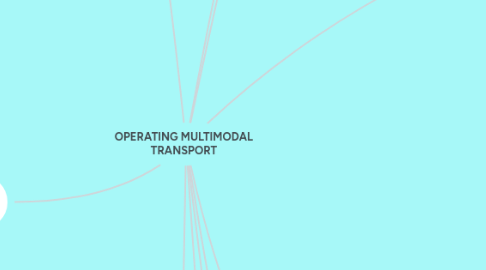
1. What is loading unit?
1.1. Combine several items into single unit
1.2. Increased flexibility when moving huge quantity of items at time
1.3. Reduce the handling and shipping cost
2. IMT Networks
2.1. Networks Strategies
2.1.1. Point-to-Point
2.1.2. Corridoe
2.1.3. Hub-and-Spoke
2.1.4. Fixed Routing
2.1.5. Flexible Routing
2.2. Transport Networks
2.2.1. Transport Route
2.2.1.1. Tangible route
2.2.1.1.1. Road, Rail
2.2.1.2. Less tangible route
2.2.1.2.1. Air, Sea
2.2.2. Transport Corridor
2.2.2.1. Different mode
2.2.2.2. One mode
2.2.3. Transport Networks
2.2.3.1. Different mode
2.2.3.2. One mode
2.3. Accesibility
2.3.1. Connectivity C1
2.3.2. Geographic Accesibility A(G)
2.3.3. Potential Accesibility A(P)
3. Transport information system
3.1. Mode of transport information
3.1.1. Road
3.1.2. Rail
3.1.3. Sea or inland water transport
3.1.4. Air
3.2. Shipment information
3.2.1. Item characteristics
3.2.2. Size
3.2.3. Weight
3.3. Information on shipping service quality requirements
3.3.1. Time
3.3.2. Cost
3.3.3. Delivery method
3.3.4. Transport documents
3.4. Information provided for route selection decisions, transportation planning, fuel and manpower norms
3.5. Information for payment and fee
3.5.1. Electronic Toll Collection
3.6. Information about packing goods into containers
3.6.1. 40' container
3.6.2. Thermal container
3.7. Information about the shipper and consignee
3.7.1. Company name
3.7.2. Address
3.7.3. Account number
3.8. Information about the time required
3.8.1. Estimated time to loading
3.8.2. Estimated time of delivery
3.9. Information serving financial activities, calculating charges, setting costs, and preparing transport documents
3.10. Information provided for tracking and tracking shipments
3.10.1. Tracking and tracing
4. Intermodal Loading Unit (ILU)
4.1. Tools
4.1.1. Container
4.1.1.1. Rail, Road, Sea
4.1.1.2. TEU, FEU
4.1.2. ULD (Unit load device)
4.1.2.1. Air transport
4.1.2.2. Swap-body, semi trailer, kangaroo system
4.1.2.2.1. Road, rail in EU, US
4.1.2.2.2. Euronorm EN 283 and EN 284
4.1.2.2.3. Swap-body
4.1.2.3. The container design is suitable for air cargo transportation
4.1.3. Pallet
4.1.3.1. For goods movements
4.1.3.2. Increase the number of goods in units to load & unload
4.1.3.2.1. More efficient in handling
4.1.3.2.2. Easily re-arrange, adjust
4.1.3.2.3. Working standardisation
4.1.3.2.4. 20' container
4.1.3.3. Divide
4.1.3.3.1. Fabricated materials (wood, plastic,...)
4.1.3.3.2. Size according to EUR-pallet, ISO-pallet
4.1.3.4. Types of pallet
4.1.3.4.1. Plat pallet
4.1.3.4.2. Box pallet
4.1.3.4.3. Push pallet
4.1.3.4.4. Pallet for fixing goods
4.2. SCAC - Standard Carrier Alpha Code (US)
4.3. ILU-code (EU)
5. Activities
5.1. Pack and unpack shipment
5.2. Points of transfer between means of transport
5.3. Points of transfer between modes of transport
6. Concentrating goods
7. INTERMODAL TERMINAL
7.1. Definition
7.1.1. Points of transfer between modes of transport
7.1.2. Handling freight
7.2. Classify
7.2.1. Evaluating ability of goods concentration
7.2.1.1. Gini coeficient (G)
7.2.1.2. Delphi forecasting: 6 steps
7.2.2. Modes of transport
7.2.2.1. Road
7.2.2.2. Rail
7.2.2.3. Air
7.2.2.4. Sea
7.2.3. Service routes
7.2.3.1. Direct connection
7.2.3.2. Corridor
7.2.3.3. Hub & spoke
7.2.3.4. Fixed roues
7.2.3.5. Flexible routes
7.2.4. Functions
7.2.4.1. Break bulk terminal
7.2.4.2. Multi purpose terminal
7.2.4.2.1. Terminal for special goods
7.2.5. Ancillary-added value
7.2.5.1. Trade facilitation
7.2.5.2. Distribution centers
7.2.5.3. Storage depot
7.2.5.4. Container services
7.2.6. Terminal for container
7.2.7. Ability of providing logistics services
7.2.7.1. Modes of transport
7.2.7.2. Distribution center
7.2.7.3. Transloading
7.2.7.4. Cross-docking
7.2.7.5. Warehousing
7.3. Consist of
7.3.1. Hinterland
7.3.2. Foreland
7.4. Features
7.4.1. Core operations
7.4.1.1. infrastructure
7.4.1.2. Equipment
7.4.1.3. Storages
7.5. Management
7.6. Affection
7.6.1. Location
7.6.2. Accessibility
7.6.3. Infrastructure
7.6.4. Safety and security
7.6.5. Economy
7.7. Policy
8. Process of operating MT
8.1. MT organization process (11 step)
8.1.1. Receiving information/Negotiating the special requirements
8.1.2. Selecting the combination of transport modalines
8.1.3. Sellect the carrier(route, cost & frieght, option)
8.1.4. Planning/implementing/check, finalizi the result/ sovling complaint
8.2. Basic for selecting modes of transport & carrie
8.2.1. Transport
8.2.1.1. Route/ distance/ goods/ freight rate
8.2.1.2. Time/ service requirements/ transport
8.2.1.3. Capability
8.2.2. Carrier
8.2.2.1. On time
8.2.2.2. Effective cost
8.2.2.3. Reliabiliti level: meet requirements and reduce storage level
8.2.2.4. Ability &capacity
8.2.2.5. Security: Lowest damage of goods
8.3. MT cost structure
8.3.1. MT chain
8.3.1.1. Composition
8.3.1.1.1. Conection
8.3.2. Intermodal transport cost (CT)
8.3.2.1. Consist
8.3.2.1.1. Local or regional distribution cost: C(cp), C(de)
8.3.2.1.2. Fation or international distribution cost: C(cn), Ci
8.3.2.1.3. C(T)=C(cp)+C(cn)+C(I)+C(de)
8.4. Implementation process (8 step)
8.4.1. IMTO receive the shipment
8.4.2. Domestic+transport (export country)
8.4.3. Custom procedure (loading)
8.4.4. International transport route
8.4.5. Receive good/ custom/ dometic/ delivery
9. Classifision of MT
9.1. By combination of transport modarity
9.1.1. Sea-air(Sea/air/sea): low cost +fast speed
9.1.2. Air-road(road/air/road):fast speed+flexible
9.1.3. Rail-road-iwwt-sea
9.1.4. land-sea-land and RO/RO (seea-road)
9.1.5. Lash-lighter aboard ship : larger number of ship goods
9.1.6. Transcontinenta bridge: land-bridge/ mini-bridge/micro bridge
9.1.7. Piggyback (TOFC) trailer on flat car
9.1.8. COFC : containers on flat cars
9.2. By type of cargo
9.2.1. Normal cargo
9.2.2. Project cargo: for factory project such as energy,...
9.2.3. Overweight, oversize
9.3. By service
9.3.1. FCL/FC: full container
9.3.2. LCL/LCL: less than container
9.3.3. FCL/LCL: one sender but more than one recipient per container
9.3.4. LCL/FCL: more than one sender but one recipient per container
10. MT operator
10.1. Classification MTO
10.1.1. VOCC/AOCC
10.1.2. NVOCC/NAOCC
10.1.3. VOCC+NVOCC
10.2. Means
10.2.1. any person acting
10.2.2. on his behalf concludes
10.2.3. a MT contract and who
10.2.4. acts as principal, not as an agent or on behalf of the consignor, and who assumes responsibiity for the performance of the contract
